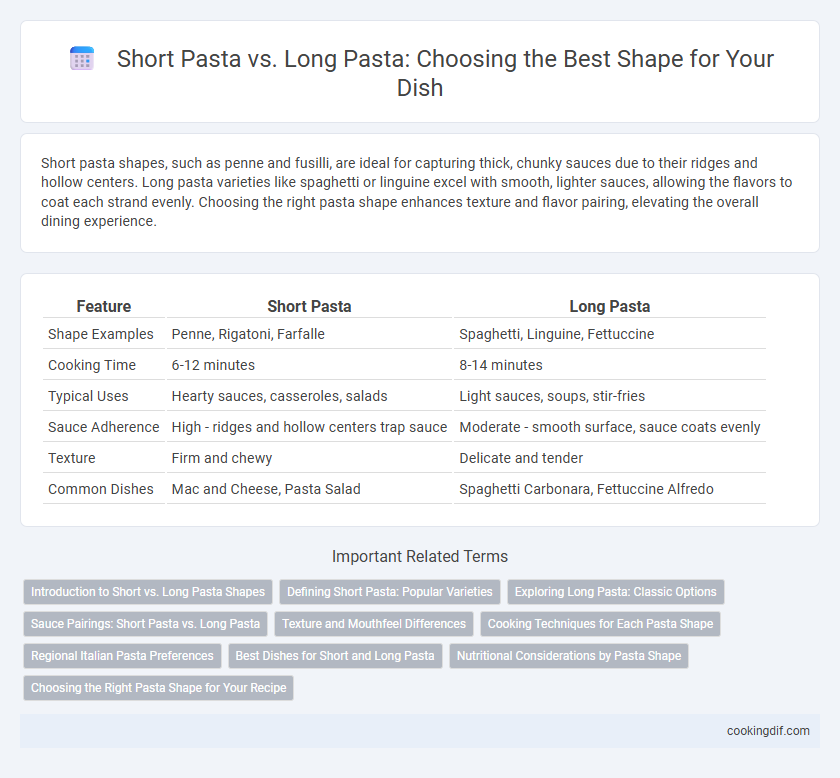Short pasta shapes, such as penne and fusilli, are ideal for capturing thick, chunky sauces due to their ridges and hollow centers. Long pasta varieties like spaghetti or linguine excel with smooth, lighter sauces, allowing the flavors to coat each strand evenly. Choosing the right pasta shape enhances texture and flavor pairing, elevating the overall dining experience.
Table of Comparison
| Feature | Short Pasta | Long Pasta |
|---|---|---|
| Shape Examples | Penne, Rigatoni, Farfalle | Spaghetti, Linguine, Fettuccine |
| Cooking Time | 6-12 minutes | 8-14 minutes |
| Typical Uses | Hearty sauces, casseroles, salads | Light sauces, soups, stir-fries |
| Sauce Adherence | High - ridges and hollow centers trap sauce | Moderate - smooth surface, sauce coats evenly |
| Texture | Firm and chewy | Delicate and tender |
| Common Dishes | Mac and Cheese, Pasta Salad | Spaghetti Carbonara, Fettuccine Alfredo |
Introduction to Short vs. Long Pasta Shapes
Short pasta shapes like penne, rigatoni, and farfalle excel in holding chunky sauces and adding texture to baked dishes, while long pasta varieties such as spaghetti, fettuccine, and linguine are ideal for smooth, lighter sauces that coat each strand evenly. Short pasta's ridges and hollow centers trap ingredients, enhancing flavor complexity in hearty recipes. Long pasta's slender forms allow for elegant presentation and are traditionally paired with olive oil or cream-based sauces, emphasizing simplicity and balance in Italian cuisine.
Defining Short Pasta: Popular Varieties
Short pasta refers to small, often tubular or shaped pasta varieties designed to hold sauces effectively and provide a satisfying texture. Popular examples include penne, rigatoni, and farfalle, each featuring unique ridges or shapes that trap sauces such as marinara or pesto. These varieties contrast with long pasta like spaghetti or linguine, as their compact form makes them ideal for baked dishes, pasta salads, and hearty, chunky sauces.
Exploring Long Pasta: Classic Options
Long pasta varieties such as spaghetti, fettuccine, and linguine offer versatile shapes that pair well with both light and rich sauces, enhancing texture and flavor absorption. These classic options provide a satisfying bite and are ideal for dishes featuring smooth, creamy, or oil-based sauces that cling to their strands. Selecting the right long pasta shape enriches the culinary experience by complementing sauce consistency and ingredient profiles.
Sauce Pairings: Short Pasta vs. Long Pasta
Short pasta shapes like penne, rigatoni, and fusilli hold chunky sauces, meat, and vegetables better due to their grooves and tubes, making them ideal for thick, hearty sauces such as marinara or Bolognese. Long pasta varieties like spaghetti, linguine, and fettuccine are best paired with smooth, lighter sauces like olive oil-based dressings, seafood sauces, or simple garlic and herb blends that coat the strands evenly. Choosing the right pasta shape enhances sauce adherence and balances texture, improving the overall flavor experience.
Texture and Mouthfeel Differences
Short pasta shapes like penne or fusilli offer a firmer texture and a more substantial mouthfeel due to their compact structure, which holds sauces well in the crevices. Long pasta varieties such as spaghetti or fettuccine provide a smoother, silkier texture that allows for a more uniform coating of lighter sauces. The choice between short and long pasta significantly impacts the dining experience, as texture and mouthfeel vary based on shape and sauce adherence.
Cooking Techniques for Each Pasta Shape
Short pasta like penne and rigatoni cooks quickly and thoroughly in boiling water, making it ideal for baking and hearty sauces that cling to its ridges and tubes. Long pasta such as spaghetti and fettuccine requires gentle stirring during boiling to prevent sticking and benefits from delicate, lighter sauces like olive oil or cream-based ones that evenly coat the strands. Cooking times vary with shape and thickness, emphasizing the importance of timing and sauce pairing to optimize texture and flavor.
Regional Italian Pasta Preferences
Southern Italy favors short pasta shapes like penne, rigatoni, and orecchiette, which effectively capture hearty sauces such as ragu and tomato-based condiments. Northern Italy commonly prefers long pasta varieties like tagliatelle, pappardelle, and spaghetti, ideally paired with rich, creamy sauces or delicate seafood. Regional ingredients and culinary traditions significantly influence the choice between short and long pasta across Italy.
Best Dishes for Short and Long Pasta
Short pasta varieties like penne, rigatoni, and farfalle are ideal for thick sauces, baked dishes, and salads due to their ability to hold chunky or creamy sauces well. Long pasta types such as spaghetti, fettuccine, and linguine pair excellently with light olive oil-based sauces, seafood, and smooth tomato sauces, enhancing the overall texture and flavor experience. Choosing the right pasta shape optimizes sauce adherence and complements the dish's ingredients for authentic Italian cuisine.
Nutritional Considerations by Pasta Shape
Short pasta shapes like penne and fusilli often hold thicker, denser sauces, potentially increasing calorie intake per serving compared to long pasta such as spaghetti or linguine, which are typically paired with lighter sauces. Nutritionally, long pasta may promote slower digestion due to its uniform shape and surface area, aiding in better blood sugar regulation. Both types offer similar macronutrient profiles, but variations in texture and sauce absorption can influence overall satiety and nutrient absorption.
Choosing the Right Pasta Shape for Your Recipe
Short pasta shapes like penne, rigatoni, and farfalle are ideal for capturing chunky sauces, baked dishes, and pasta salads due to their ridges and hollow centers that hold sauce effectively. Long pasta varieties such as spaghetti, linguine, and fettuccine pair best with lighter, smoother sauces like marinara or Alfredo, allowing the sauce to evenly coat each strand. Selecting the right pasta shape enhances texture and flavor absorption, ensuring the perfect harmony between sauce and pasta in every dish.
short pasta vs long pasta for shapes Infographic

 cookingdif.com
cookingdif.com